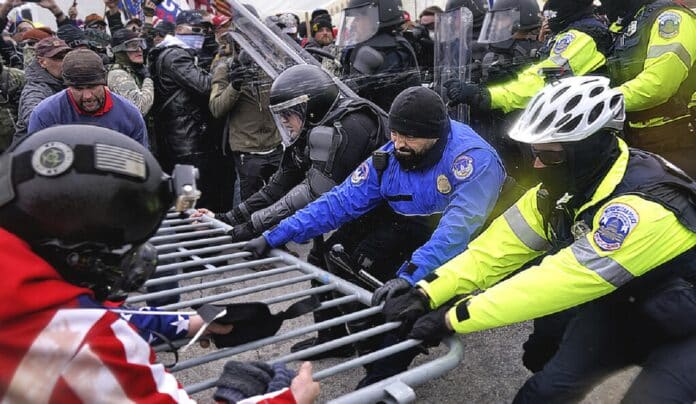The relationship between social media use and subsequent offline social behavior is still being determined. According to some studies, social media has an impact on social attitudes.
According to a new study led by Yale sociologist Daniel Karell, increased social media activity on “hard-right” platforms, which purport to represent viewpoints not welcome on “mainstream” platforms, contributes to rightwing civil unrest in the United States.
The analysis of data from hard-right social media activity and incidents of civil unrest that occurred “offline” in the United States between January 2020 and January 2021. According to the researchers, A 10% increase in hard-right social media activity predicts a.04% increase in hard-right civil unrest events the following month.
Karell, assistant professor of sociology in Yale’s Faculty of Arts and Sciences and the study’s lead author, said, “The magnitude of the effect we found is modest, but two characteristics of social media and civil unrest caution against dismissing it. First, hard-right social media platforms are easy to join, increasingly popular, and attracting more than a billion dollars in investment, meaning activity on them could grow rapidly. Second, as demonstrated by the January 6 riot at the U.S. Capitol, a single incident of hard-right civil unrest can be very consequential.”
They also discovered that activity on far-right platforms alters users’ perceptions of social norms in ways consistent with their previously held beliefs. This is especially true when users see their own words echoed in the rhetoric of hard-right “elites” on social media, prominent pundits, celebrities, and politicians whose content is amplified by the platforms. Users are more likely to engage in contentious activity previously considered taboo due to this shift in the understanding of social norms.
Andrew Linke, Edward Holland of the University of Arkansas, and Edward Hendrickson, Karell’s research assistant at Yale, coauthored the study, which was published in the journal American Sociological Review.
The text’s most important detail is that social media platforms with a strong focus on financial gain and profit are referred to as “hard right” rather than “extreme right.” This is because most of the content posted on them aligns with mainstream conservative views. It is meant to emphasize that the majority of the content on these platforms is socially and politically conservative but also obstinately opposed to compromise with the political left and center.
According to the researchers.Multiple data sources were used in the analysis, including the Armed Conflict Location and Event Data project, the Crowd Counting Consortium, and the Parler social media platform. U.S. Census Bureau then mapped the data core-based statistical areas and counties.
The researchers define “hard-right social media” in the same way platforms and websites commonly referred to as “alt-tech” are defined. Hard-right social media platforms, like alt-tech platforms, claim to support viewpoints that are not welcome on mainstream platforms or within the corporations that operate them. However, they differ from other alternative technology platforms in two ways.
First, while they frequently describe themselves as open forums dedicated to free speech, the researchers explained that political conservatives almost entirely use them. Second, they place a strong emphasis on financial gain and profit. In contrast, much of alt-tech, at least in its early stages, avoided profit-making.
Multiple data sources were used in the analysis. They obtained records from the Armed Conflict Location and Event Data project, a non-governmental initiative that collects data on political violence and protest in 100 countries, and the Crowd Counting Consortium, a scholarly project that documents contentious events across the United States that occurred during the study period.
They also accessed a database of all activity on the hard-right social media platform Parler in 2020, which included accurate location information. They created a database of thousands of videos created and shared by Parler users in 2020 and early 2021.
U.S. Census Bureau then mapped the data core-based statistical areas and counties, which are geographic units with at least 10,000 people and an urban center. The researchers looked at the content of people’s posts on Parler to see if there was a link between hard-right social media activity and subsequent hard-right civil unrest.
They discovered no evidence that people frequently used the platform to plan incidents of unrest, and only two of the 50 most frequently used words, “joined” and “meeting,” appear to be related to coordinating activity. According to the study, neither accounts for more than 0.5% of all words used on Parler.
They also assessed how closely statements made by hard-right “elites” on Parler reflected ideas expressed by non-elites the previous month. They discovered evidence that when non-elite users see their ideas represented in commentary by prominent users, their perceptions of social norms change, aligning these perceptions with their current views and behavior.
Karell from yale university said, “There is a lot of support in the sociology literature for the idea that people often understand social norms from cues they receive from elite or admired people in their groups, and we found evidence for this among people using hard-right social media.”
He also said, “When people see their existing beliefs and values reflected in elite commentary, previous research tells us this would have a validating effect that makes them perceive their views and ensuing behavior as more socially acceptable than they previously thought. As a result, people might subsequently take actions they would have previously avoided.”
Journal Reference:
- Karell, D., Linke, A., Holland, etal. “Born for a Storm”: Hard-Right Social Media and Civil Unrest. American Sociological Review. DOI: 10.1177/00031224231156190
